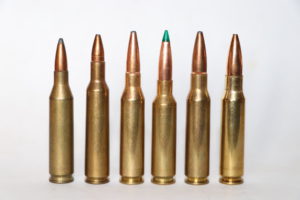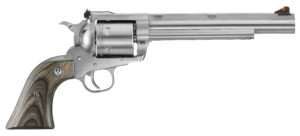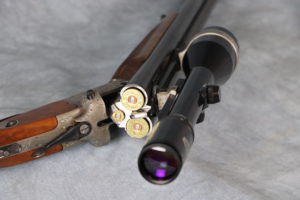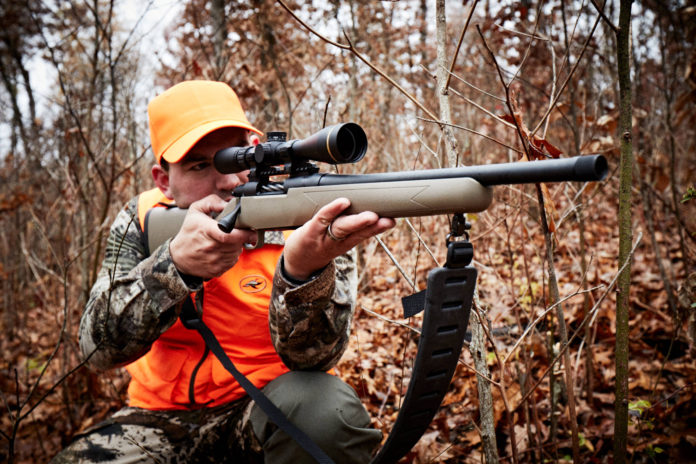BY STEVE COMUS
Wild pig hunting just keeps getting more popular all the time. And why not? It happens all year long, is as sporting as anything out there and often results in some really good eating.
Although many other regions of the country in recent years have seen a massive proliferation in the number of wild pigs in areas where historically there were none, California has had significant wild pig hunting for decades.
Some hunters like to go for the huge tusker boars, while others opt for succulent sows or smaller pigs for table fare. Regardless, there is nothing like a hog hunt this time of year to keep in shape and maximize the fun factor.
The style of a hunt can dictate what kind of guns and ammo are needed. Shots can be up-close or far. The hunter merely needs to match gun, ammo and hunting style in a way that the right bullet is put in the right place to do the job.

For rifles, anything from the .243 Winchester on up can work fine. Eldon Bergman, one of the original hog-hunting guides in the Central Coast, used a Savage 99 in .243 on hogs for decades.
I did quite a bit with .25 caliber rifles, mostly in .257 Roberts and .257 Weatherby Mag. Both work great on hogs.
Although I have had no personal experience with them on hogs, the new 6.5mm cartridges — Creedmoor and PRC — most certainly should work great.
After all, the 6.5x55mm Swedish and the .264 Winchester Mag both worked great over the years, and they are essentially ballistic twins of the two newer 6.5s, as well as the .260 Remington or 6.5mm Grendel.
There are a couple of popular .27 caliber cartridges and they both also work great on porkers. They are the .270 Winchester and .270 Weatherby Mag. SIG has created a high performance .270 cartridge for military use that is envisioned becoming a hunting round, but it is too new to know much about, except that its ballistics indicate it would be a good hog hunting cartridge.

For 7mm fans, 7-30 Waters, 7mm-08 Remington, .280 Remington, .284 Winchester and any of the 7mm Mags also work great on hogs.
Without doubt, .30 caliber is the most commonly used for hogging. Think .30/30 Winchester, .308 Winchester, .30-06 Springfield or any of the .300 Mags.
Larger bore rifles also can work fine, like the .35 Whelen, .45/70 Govt. or .444 Marlin. With any of the lever-action rifle/cartridge combinations, it is important to keep the shots to the effective distances of the rifle/cartridge combo. In general terms, this is 100 yards or less. And, the Winchester .350 Legend is making a name for itself in the hog hunting world.
Handgun hogging can be fun, whether the handgun is used as the primary firearm or as a coups de grace implement.
In practical terms, the .357 Mag represents the lower end of performance for handgun hogging. For revolvers, the .41 and .44 Mags are nice, or for those who like semi-autos, 10mm Auto has a lot going for it.

Although the .45 ACP is probably not quite up to snuff as a primary arm for hogging, it can serve well if there is a need to finish the job. Same with the .45 Colt.
However, cartridges like the .454 Casull and .460 S&W Mag
can be both primary and secondary arms. Any of the .50s (.50 Action Express or .500 S&W, for example) also can serve dual duty.
Traditionally, bolt-action rifles dominated the hog hunting scene, with lever-actions some-what common. But that is not necessarily the case now. Semi-autos like the AR-10 variants are popping up more all the time.
It makes sense because semi- autos offer quick follow-up shots, and often in hogging, follow-ups are needed.
The important thing to remember is that the rifle needs to be used to its fullest potential. For example, a very accurate rifle chambered for a high-performance cartridge can be valid at longer distances where a well-aimed first shot from some kind of a rest is common.
Yet, when brush busting or kicking pigs out of bush-choked canyons, there usually is no way to use a rest and rarely time to take a really well-aimed shot. There is a lot of instinctive shooting in such scenarios.

The idea for each hunter is to know what kinds of shots he or she can make repeatedly and to stay within those parameters, whatever they might be. Some hunters are more competent at 300 yards than others are at 50 yards. Ethics dictate that the shots should be well placed so they deliver a quick kill.
There is a rather odd phenomenon that happens sometimes on big, old boar hogs that have a really thick cartilage-like shield under their skin that helps protect them from other hogs and can cause some interesting bullet ballistic anomalies.
Most hunting bullets from centerfire rifles can penetrate the shield, which can be up to
about two inches thick. The interesting thing is that sometimes slower moving bullets to a better job penetrating than do really high velocity ones.
From what I have seen over the years, when the really high-speed bullets hit the shield, they open up/flatten out much more quickly, which in turn causes more resistance as they enter the body.
Translated into common language, this means that the same .30 caliber bullet can penetrate better from a .308 Winchester than from a .300 Winchester Mag.
Of course, all of this depends on the impact velocity, individual bullet and individual hog. But it has seemed that impact velocities of 2,000 to 2,300 feet per second by the same bullet result in better penetration through the armor and into the hog than do higher impact velocities.
However, this is not to suggest that the magnums don’t work. They do. It is just the manner in which they work that is different.
Or, for hunters who want to add another dimension to a hog hunt, why not consider a European combination gun, like a drilling — three-barreled gun that typically includes side-by- side shotgun barrels over a centerfire rifle barrel?
Such guns are used widely for hog hunts in Europe and they work great. Europeans use combination guns primarily because of the taxes and laws there that make it handier to be able to have a single firearm perform a wider variety of tasks.
I have a couple of drillings, one of which is a J.P. Sauer u. Sohn with two 12-gauge barrels and a .30-06 Springfield barrel. A 4-12x Schmidt & Bender scope in claw mounts pops on quickly for longer shots with the rifle barrel, or off for quicker shots with the rifle barrel or shotgun barrels, or for when the shotgun barrels are used to hunt flying birds.
Whenever hog hunting is discussed, there should be an obligatory disclaimer: Hog hunting can be habit-forming. Truly, it is one kind of hunting that is worth considering — especially when it is off-season for other game species.




